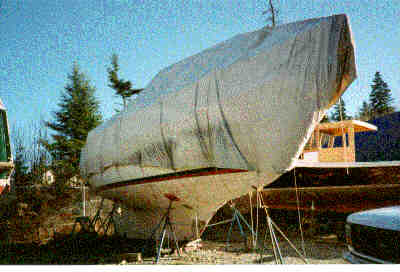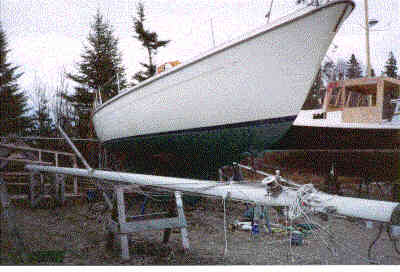Epoxy Bottom Job
Seaquestor's Epoxy Bottom Job
 The picture at left shows Seaquestor in early November 1996 after the bottom was sand blasted to remove the old bottom paint. Note the area on the leading edge of the keel where a repair has been done. In addition to removing the bottom paint, the sand blasting also revealed that the hull gel coat had hundreds of small (1/32" to 1/8") pin holes. Thus, it seemed likely that the hull was quite wet, so I decided to leave the boat with its bottom exposed over the winter for it to dry out thoroughly.
The picture at left shows Seaquestor in early November 1996 after the bottom was sand blasted to remove the old bottom paint. Note the area on the leading edge of the keel where a repair has been done. In addition to removing the bottom paint, the sand blasting also revealed that the hull gel coat had hundreds of small (1/32" to 1/8") pin holes. Thus, it seemed likely that the hull was quite wet, so I decided to leave the boat with its bottom exposed over the winter for it to dry out thoroughly.
In mid-April 1997 I started the bottom job by sanding the bottom with 50-60 grit paper to remove adhering paint and to provide a uniformly smooth surface on which to work. After sanding, I removed dust with a brush and then wiped the surface with paint thinner (mineral spirits) to clean it. I took that approach because the boatyard (located in Maine) did not yet have the outside water turned on. The first step in the bottom job was to fill the pin holes. I used thickened West System epoxy for that job. The epoxy was thickened by mixing in West System low density filler to give a paste-like consistency. I applied the epoxy paste to the hull with a 3" plastic body filler spreader. It took about 4 hours to do each side of the hull. During this stage, I also used the thickeded epoxy to fair around the repair on the leading edge of the keel and around the locations of the knot meter impeller and the depth sounder transducer. I also filled gel coat cracks around the propellor aperture. After applying the first layer of filler, I left the epoxy to cure for a week. When I returned to the boat, I sanded the hull again with 60 grit paper (using my finish sander). During sanding it became clear that I would have to apply thickeded eopxy to the hull again in order to completely fill all of the pin holes. Thus, I spent another day applying thickened eopxy to the hull and then left for another week to permit the eopxy to completely cure.
When I returned, I sanded the hull with 100 grit paper and was ready to begin application of the epoxy barrier coat. I used West System epoxy with barrier coat additive for the barrier coating. I three barrier coats on the same day using thin foam rollers. The only tricky part was sizing the batches of epoxy. If I made the batches too big, the epoxy became extremely tacky near the ned of application of a batch, which tore the roller up. The only down side to making a batch too small, was that I had to make more batches. I finally arrived on a five pump stroke batch size (using mini-pumps that for the one gallon size West System epoxy. I was able to apply the three coats to the entire boat in about 10 hours (10:00 A.M. to 8:00 P.M.). The night I finished the barrier coating was quite cold (35 degrees F) so when I came back at 7:00 A.M. the next day, the epoxy was still at the initial cure stage (i.e., no longer tacky but still soft enough to indent with a finger nail) and had not yet given off its amine blush. Thus, I was able to apply bottom paint directly to the epoxy without sanding. I applied two coats of green Petit ACP-50 copolymer ablative bottom paint to the entire boat and went home again for a week to let the epoxy and the bottom paint cure.
 I returned to the boat a week later and, with the help of the boat yard, moved the seven (7) jack stands supporting the boat. That exposed the areas of the hull that I had not yet done (about 7 square feet in all). I sanded those areas and filled all pin holes with thickened epoxy. Because of the small area, I was able to fill all pin holes with only one application of epoxy by simply applying an extra thick layer. The next day I sanded the newly filled areas smooth with 100 grit paper and applied three barrier coats and one coat of bottom paint. I also applied a third coat of bottom paint to the leading edge of the hull and keel and to the propellor aperture and rudder. On the third day of this trip, I applied a second coat of bottom paint to the newly coated areas and a fourth coat of bottom paint to the leading edge of the keel and hull and the area around the propeller. The picture at right shows the finished bottom.
I returned to the boat a week later and, with the help of the boat yard, moved the seven (7) jack stands supporting the boat. That exposed the areas of the hull that I had not yet done (about 7 square feet in all). I sanded those areas and filled all pin holes with thickened epoxy. Because of the small area, I was able to fill all pin holes with only one application of epoxy by simply applying an extra thick layer. The next day I sanded the newly filled areas smooth with 100 grit paper and applied three barrier coats and one coat of bottom paint. I also applied a third coat of bottom paint to the leading edge of the hull and keel and to the propellor aperture and rudder. On the third day of this trip, I applied a second coat of bottom paint to the newly coated areas and a fourth coat of bottom paint to the leading edge of the keel and hull and the area around the propeller. The picture at right shows the finished bottom.
All together this job took me 12 (typically 10 hour) days. I used 3 gallons of epoxy, two containers of low density filler, 4 cans of barrier coat additive and two gallons of bottom paint. Including sand paper, paint brushes, rollers, roller pans, gloves and a pair of disposable coveralls, the entire job cost approximately $650.00. I also spent 8 nights in motels (about $400.00) and ate in restaurants (about $120.00 for breakfast and dinner only for me only). However, since my boat is located next to Acadia National Park and my wife took the opportunity to hike a lot of the trails, I consider the motel and food costs to be a sort of vacation. In the end, I got a new bottom for a bargain price and the staisfaction of doing the job myself.
This document:http://geocities.datacellar.net/TheTropics/8005/hulljob.html
This page posted by  Get your own Free Home Page
Get your own Free Home Page